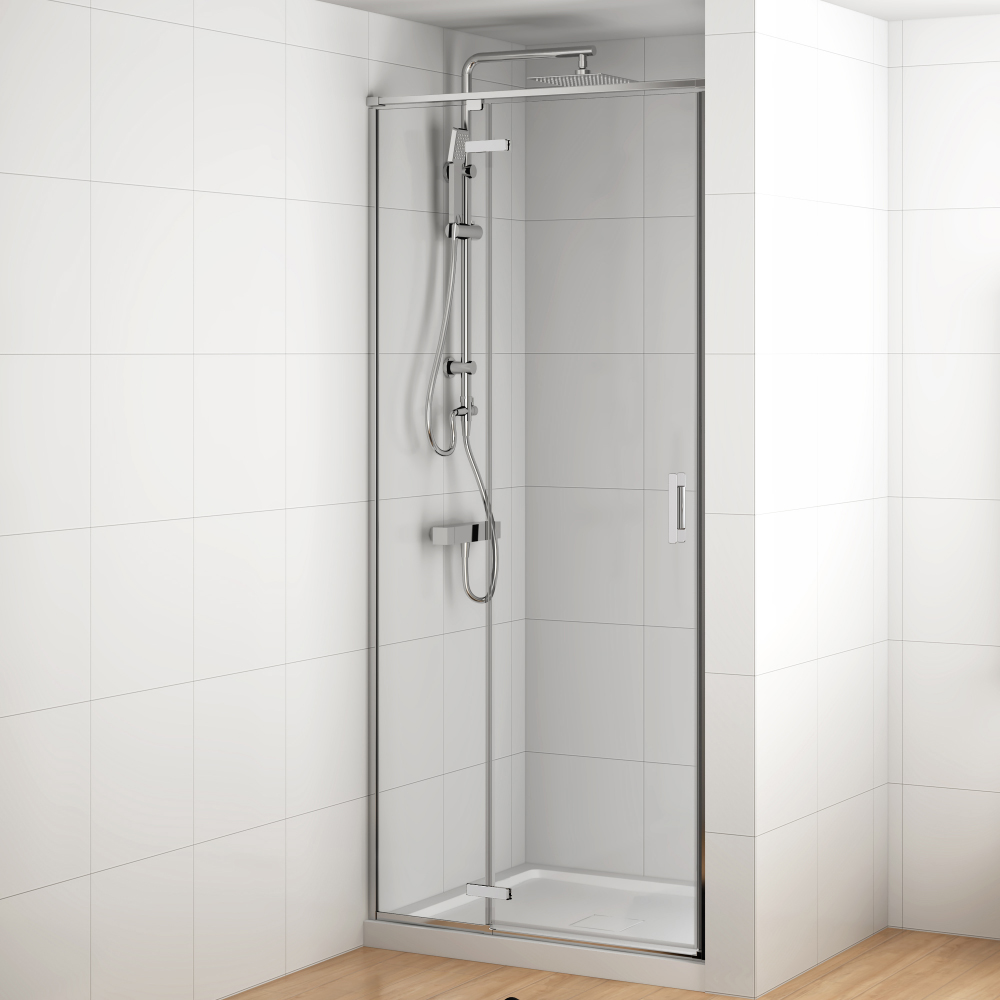I. Unlocking a Comfortable Bathroom Experience: Analysis of Pivot Shower Door Advantages
Pivot shower doors, often referred to as hinged or swing doors, hold a significant position in modern bathroom spaces thanks to their simple, elegant appearance and exceptional functionality. They achieve their inward or outward opening motion through hinges connected to the wall or a fixed glass panel, providing a wide and unobstructed entry and exit. This full-opening design is particularly friendly to users with mobility challenges, greatly enhancing convenience and safety. Compared to sliding doors, pivot doors feature fewer tracks and complex mechanical components, making cleaning much simpler and more thorough, effectively preventing the accumulation of dirt and soap scum to maintain long-lasting pristine clarity. Furthermore, this structural design typically offers superior sealing, which is better at achieving effective wet and dry separation, making it an ideal choice for families pursuing a high quality of life.
II. Determining the Ideal Size for a Pivot Shower Enclosure and Space Planning
Determining the appropriate size for a pivot shower enclosure is a crucial step in ensuring both its functionality and comfort. The design must fully consider the actual bathroom area and the user's physique; generally, the minimum internal clear dimension of the shower enclosure should be no less than $900mm \times 900mm$ to ensure the user can freely turn and raise their arms during showering. More importantly, when planning the pivot door, sufficient space must be reserved for the door panel to fully open , which usually requires at least $600mm$ to $800mm$ of safe maneuvering area outside the door. If space is limited, an inward-opening design can be considered, but it is essential to ensure that the internal space is adequate to avoid inconvenience or discomfort for the user. Accurate measurement and thoughtful space planning are the prerequisites for installing a comfortable pivot shower enclosure.
III. Saying Goodbye to Wet Floors: Solutions for Pivot Shower Door Leakage Prevention
Water leakage from shower doors is a common problem encountered by many households, but it can be effectively solved by adopting a series of targeted measures. Firstly, the installation of a door threshold or water retaining strip at the bottom is crucial; it needs to fit snugly against the floor to form a physical barrier that prevents water from spilling out. Secondly, the edges of the door panel and fixed glass typically require the use of specialized waterproof seals or gaskets . These seals should have good elasticity and aging resistance to ensure a tight seal between all contacting surfaces when the door is closed. During installation, neutral silicone sealant must be used for a thorough sealing treatment at the connections between the wall, floor, and the shower enclosure profiles, especially at the corners and bottom seams, which are critical areas prone to water penetration. Regular inspection and replacement of aging seals and silicone are key maintenance tasks for keeping the shower enclosure dry in the long term.
IV. Enhancing Aesthetics and Stability: Installation Essentials for Frameless Pivot Shower Doors
Frameless pivot shower doors are highly favored in modern home design for their minimalist and transparent visual effect, but their installation demands a higher level of craftsmanship. Since there is no frame support, the stability of the door panel relies entirely on the quality and precision of the hinges and glass . During the installation process, it is imperative to ensure that the wall is sturdy and plumb so that the hinges can be securely and accurately fixed. The cutout positions on the glass door panel must precisely match the hinge locations; any slight deviation can lead to the door panel hanging unevenly or difficulty in opening and closing. After installation, the hinges need to be carefully adjusted to ensure the door panel can self-center or stay in a preset position when closed, and perfectly align with the fixed glass or wall. This is not only about aesthetics but is also a critical step in guaranteeing sealing performance.
V. Clever Use of Space: Layout and Design of Pivot Shower Enclosures for Small Bathrooms
For small bathrooms with limited area, choosing a pivot shower enclosure might seem challenging, but an ideal wet and dry separation can still be achieved through clever layout and design. The most critical strategy is to maximize the use of corner space , for example, by adopting a diamond or pentagonal shape, which can effectively reduce the aisle area occupied when the door swings open. Another effective solution is to utilize inward-opening or bi-directional opening hinge designs; this allows the door to open inward even if the space outside is narrow, provided there is enough clear space inside the showering area for movement. In terms of visual design, using low-iron or fully transparent glass can maximize the sense of space and continuity, avoiding the feeling of confinement often associated with small spaces, making the entire bathroom appear more open and bright.
VI. Lasting as New: Routine Maintenance and Care for Pivot Shower Door Hardware
The lifespan and functionality of a pivot shower door largely depend on the quality and routine maintenance of its hardware components . The hinges , as the core bearing and rotating part of the door panel, need to be regularly checked for loose screws; if any looseness is found, they should be tightened immediately to prevent the door from sagging or warping. For stainless steel hardware, soft cloths should be used along with mild cleaning agents for wiping; avoid using excessively acidic or alkaline cleaners, as these chemicals can corrode the surface plating of the hardware, leading to rust and a loss of luster. Furthermore, applying a small amount of lubricating oil periodically to the rotating parts of the hinges can maintain their smooth operation when opening and closing, reduce wear and tear, and extend the overall life of the shower door. Good maintenance habits are essential for keeping the pivot door aesthetically pleasing and functional in the long term.


 English
English Français
Français Español
Español
